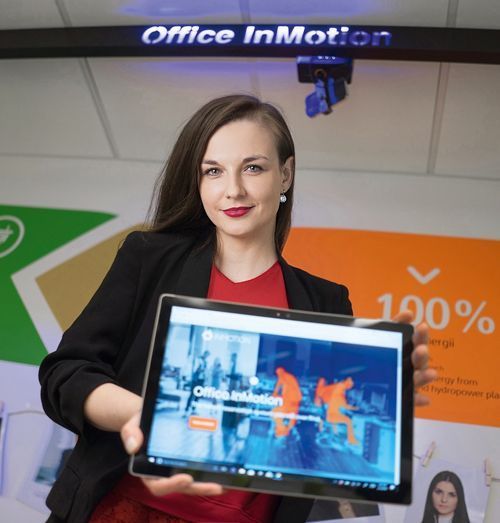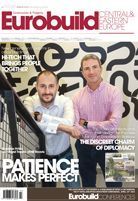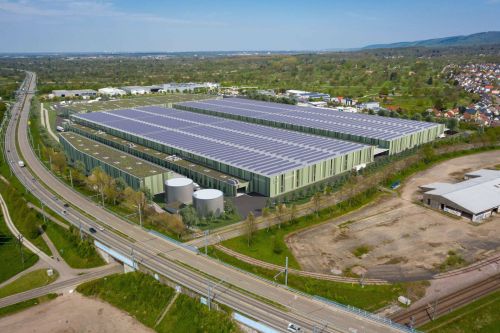Hi-tech that brings people together
Innovations by Skanska
It seems like just a few years ago when we were all astonished at the vision of the future we were given by the advent of BMS systems – tools that could take control of and analyse every technical aspect of a building’s operations, thus opening up a plethora of new options for property developers and owners as well as architects and property managers. But today BMS is already old hat and its original sin has been discovered: it only works one way – the ordinary building user is only the provider of the information it processes and cannot actively influence the system or learn from it on an ongoing basis. And, as a result, the benefits of BMS go unnoticed by the everyday employee.
Quick and safe
Interactivity, however, lies at the heart of the Connected by Skanska system, which is designed for all the users of the office building. Furthermore, everyone takes an active part in shaping the system and can see and feel its positive effects each day. Connected by Skanska makes it easier for tenants and their guests to use common areas, while improving and securing the access to the building. The elements of the system include applications installed on employees’ smartphones, a portal for tenants and managers with an administration and analytical panel, as well as the analytical engine of the system (in the cloud). The software is to be installed for all new office buildings developed by Skanska in the CEE region, with Warsaw’s Spark tower to be the first to have this honour bestowed upon it.
“First of all, by using this system people are liberated from magnetic cards, the use of which is not entirely practical or safe, especially if they are lost or fall into the wrong hands,” explains Renata Nowakowska, the innovation manager of Skanska’s office division in Poland. “Employees can enter their office using the app installed on their smartphone or smartwatch, while guests will be able to check in via a virtual reception, which will send a pass with a unique QR code to their phone. The code will have a specific expiry time and only allows you to enter a particular part of the building. Queues at reception desks and the need to pick guests up at the building’s entrance will become a thing of the past. The app will also help guests to find their desired location, which can be a challenge in large, labyrinthine buildings. In this way it not only makes life easier for tenants and their guests but also increases the security of the building, minimising access to intruders,” insists Renata Nowakowska.
Parking on demand
Activity Based Parking is another useful system developed for Skanska – and not only for motorists. No office building in the world has more parking spaces than it needs, but the system is designed to allocate the spaces it has more effectively through sensor systems installed at the spaces to monitor their occupancy. “The uniqueness of this system lies in the fact that the number of vacancies can be checked remotely, such as in the morning when setting off for work, which can help you to decide whether to go to work by car or use public transport,” says Renata Nowakowska about the advantages of the system. “What’s more interesting is that thanks to its analytical capabilities the system is able to tell us whether the company’s spaces will be free at a certain time of the day or in an hour or two. The use of selected spaces can be blocked from time-to-time, for example, for the needs of board members or guests, or used for parking on a hot-desk basis. This is an excellent solution for companies with large fleets of vehicles that are in transit for most of the day. Entering the car park will be a smooth process, without the need to stop the vehicle and take a card out, because the camera will read the licence plate and then after this verification the system will allow the user to enter the correct level of the car park. “The Connected by Skanska system also has the ability to integrate the smart technology used by tenants in their offices,” continues Renata Nowakowska, “Via bluetooth the app’s users can control such factors as the light and temperature in individual rooms or their sections. It’s also possible to remotely control the use of or book conference rooms, hot-desks or rooms for quiet work.”
Watching the desks
The Office InMotion system, which was the winner of Urban Quest, a start-up competition organised by the developer, has been trialled by Skanska in its current Polish head office. It can also be integrated with the Connected by Skanska system. “The system allows you to organise the chaos that often arises in co-working and hot-desk zones due to the sharing of desks,” explains Sławek Potasz, the CEO and founder of the InMotion start-up, which specialises in mobile cameras and sensor systems. “In such zones about 70 desks are normally allocated to 100 employees, so a suitable reservation system is needed to ensure the optimal use of workstations. The desk booking systems available on the market are usually based on beacons attached to chairs, which are susceptible to damage and require battery power. Our Office InMotion system can replace 100 of these beacons. How does it work? A small thermal imaging camera moves silently under the ceiling on a special rail, scanning the office surface and determining the exact location of everyone present. The employee can then see which places are free remotely via the app and reserve a desk using their smartphone. The system also allows you to generate statements and reports,” adds Sławek Potasz.
“Thanks to Office InMotion we can find out how the desks are used, such as, for example, the time of their maximum occupancy or which places are the most popular. This is an invaluable aid, not only for a company using the co-working model but also for interior designers,” says Sławek Potasz.
A three-month test implementation of the system is currently being carried out in Skanska’s offices, while InMotion Labs is now working on the second generation of the system – the thermal imaging camera is to be miniaturised and move along a rail that can be shaped (e.g. bent or extended).
Towards the light
Lighting control that can adjust itself to the time of day, the sunlight levels, the volume of people and to their preferences, can also be performed by the Connected by Skanska system. For many years Skanska Property has been cooperating with Philips Lighting, the company that originally came up with the concept of human-centric lighting. The idea is to focus on people and take care of their photobiological well-being, as well as the generally quality of their working conditions. A human-centric lighting concept has been implemented in the Spark office building in Warsaw.
“The term ‘green building’ remains one of the most important ideas in modern office construction, but we are now adding another important element to it – active concern for the people who regularly use the building, improving the comfort of their working conditions, taking care of their health and supporting them in their everyday activities,” declares Paweł Mrówczyński, one of the leaders of Philips Lighting’s office projects. “Thanks to the Well Building Standard, which provides a kind of definition and scale for the human-centric lighting concept, we now have clearly defined parameters and lighting functions and have used them while working on the Spark project,” he adds.
With this approach in mind, Philips Lighting has designed a control system that uses the latest available knowledge about the daily human cycle, its hormonal cycles and other psychophysical factors for Skanska’s office buildings. The significance of this field is confirmed by the fact that the Nobel Prize was awarded last year to a research team working on the impact of the daily cycle on people’s well-being – what are otherwise known as circadian rhythms.
“The technology used in the Spark building provides automatic control of the lighting level and quality in a given office space. The system is also flexible when it comes to adjusting the lighting to the time of day and external conditions, and can be personalised for the needs of each employee, also via the mobile app. This maximises the individual use of external light throughout the office,” explains Marcin Tarasiewicz, an engineer on Philips Lighting’s design team. “Innovation in terms of area personalisation also has another dimension – unique fittings have been created using 3D printing for the Spark building. Their final shape meets all the developer’s expectations in terms of the design as well as the standard of the office lighting,” adds Marcin Tarasiewicz.
Systems only for the people
“We are aiming at a completely new quality for our office buildings. Thanks to the internet-of-things, real-time data and advanced analytics, we have made using the office more convenient, effective and economical,” claims Renata Nowakowska of Skanska. “But our innovations are not only about top level technology. Our overriding goal is to improve the well-being of office users, their work comfort as well as their integration and the relationships between them. Technology without such an approach is just a bunch of gadgets,” concludes Renata Nowakowska.
Skanska is the content partner for the Innovations by Skanska section of the magazine.
-----------------------------------------------------------------------------------------------------------------------------------------------------
Arkadiusz Rudzki,
managing director, Skanska’s office division
Development has many names
We have come to the point where office buildings are now highly technologically advanced. This is already the standard for us. That’s why we are investing in innovative systems to improve security even more, during both the construction and the office’s utilisation. We are devising and developing innovations with partners from a range of industries, such as large corporations (e.g. Intel, ABB and Philips), but we are also looking for fresh ideas from partner start-ups. The importance we attach to this type of cooperation is confirmed by the fact we have established a position specially dedicated to it – we were among the first companies in our field to appoint an innovation manager solely for this area of expertise. We also have the scale needed to test out all the new systems – on different markets and in various projects. Technology is developing at such a dizzying pace, so innovative ideas and devices require quick verification and rapid implementation on a large scale, because it is only by adopting such as an approach that we will be able to transform the market.






















































